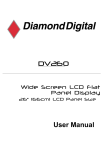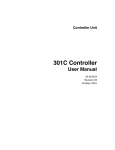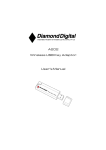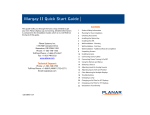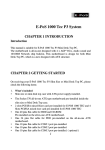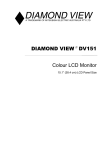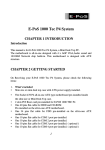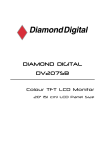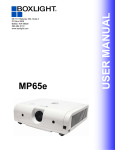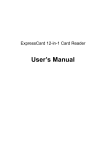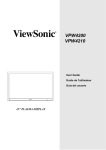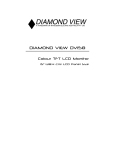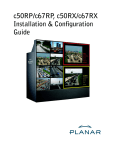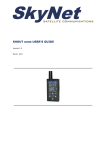Download Diamond Digital DV42P!mk2 User Manual
Transcript
ENGLISH Plasma Display USER'S MANUAL Thank you for purchasing the Plasma Display. Before using your Display, please read the "SAFETY INSTRUCTIONS" and this "USER'S MANUAL" carefully to learn how to operate the Display properly. Keep this manual in a safe place. You will find it useful in the future. Notes on lnstallation This product is marketed with the assumption that it is to be installed by qualified personnel with relevant skills and competence. It is recommended to consult with an installation specialist or your dealer install and set up the product. We cannot assume liabilities for damages caused by improper installation or mounting, misuse, modifications or natural disasters. 1 IMPORTANT SAFETY INSTRUCTIONS SAFETY POINTS THAT YOU SHOULD KNOW ABOUT YOUR Plasma Display Follow all warnings and instructions marked on this Plasma Display . The lightning flash with arrowhead symbol, within an CAUTION RISK OF ELECTRIC SHOCK DO NOT OPEN CAUTION: TO REDUCE THE RISK OF ELECTRIC SHOCK, DO NOT REMOVE THE COVER (OR BACK). NO USER SERVICEABLE PARTS INSIDE. REFER SERVICING TO QUALIFIED SERVICE PERSONNEL. WARNING: equilateral triangle, is intended to alert the user to the presence of uninsulated "dangerous voltage" within the product's enclosure that may be of sufficient magnitude to constitute a risk of electric shock to persons. The exclamation point within an equilateral triangle, is intended to alert the user to the presence of important operating and maintenance (servicing) instructions in the literature accompanying the appliance. z TO AVOID FIRE OR ELECTROCUTION, DO NOT EXPOSE THIS MONITOR TO RAIN OR MOISTURE. zTHE MONITOR SHOULD NOT BE EXPOSED TO DRIPPING OR SPLASHING AND OBJECTS SUCH AS VASES FILLED WITH LIQUIDS, SHOULD NOT BE PLACED ON THE DISPLAY. z There are no user serviceable parts inside the DISPLAY. z Model information and serial numbers are indicated on the NOTE: rear side of the DISPLAY. CAUTION: Adjust only those controls that are covered in these instructions, as improper changes or modifications not expressly approved by us could void the user's authority to operate the DISPLAY. MODIFICATIONS: The FCC requires that the user be notified that any changes or modifications made to this device, that are not expressly approved by us may void the user's authority to operate the equipment. POWER SOURCE THIS DISPLAY IS DESIGNED TO OPERATE ON 100-240 VOLT 50/60Hz, AC CURRENT. INSERT THE POWER CORD INTO A 120 VOLT 60Hz or 240 VOLT 50Hz OUTLET. TO PREVENT ELECTRIC SHOCK, DO NOT USE THE DISPLAY (POLARIZED) PLUG WITH AN EXTENSION CORD, RECEPTACLE, OR OTHER OUTLET UNLESS THE BLADES AND GROUND TERMINAL CAN BE FULLY INSERTED. THIS IS TO PREVENT BLADE EXPOSURE. NEVER CONNECT THE DISPLAY TO DIRECT CURRENT OR ANYTHING OTHER THAN THE SPECIFIED VOLTAGE. CAUTION: 2 Never remove the back cover of the Plasma Display as this can expose you to very high voltages and other hazards. If the Plasma Display does not operate properly, unplug the Plasma Display and call your authorized dealer or service center. ENGLISH Our reputation has been built on the quality, performance, and ease of service of Plasma Display . Safety is also foremost in our minds in the design of these units. To help you operate these products properly, this section illustrates safety tips which will be of benefit to you. Please read it carefully and apply the knowledge you obtain from it to the proper operation of your Plasma Display . Read before operating the appliance Follow all warnings and instructions marked on this Plasma Display . 1. Read these instructions. 2. Keep these instructions. 3. Heed all warnings. 4. Follow all instructions. 5. Do not use this appliance near water. 6. Clean only with a dry cloth. 7. Do not block any ventilation openings. Install in accordance with the manufacturer's instructions. 8. Do not install near any heat sources such as radiators, heat registers, stoves, or other appliances (including amplifiers) that produce heat. 9. Do not defeat the safety purpose of the polarized or groundingtype plug. A polarized plug has two blades with one wider than the other. A grounding type plug has two blades and a third grounding prong. The wide blade or the third prong are provided for your safety. If the provided plug does not fit into your outlet, consult an electrician for replacement of the obsolete outlet. 10.Protect the power cord from being walked on or pinched, particularly at plugs, convenience receptacles, and at the point where they exit from the appliance. 11.Only use the attachments/accessories specified by the manufacturer. 12 Use only with the cart, stand, tripod, bracket, or table specified by the manufacturer, or sold with the appliance. When a cart is used, use caution when moving the cart/appliance combination to avoid injury from tip-over. 13.Unplug this appliance during lightning storms or when unused for long periods of time. 14.Refer all servicing to qualified service personnel. Servicing is required when the appliance has been damaged in any way, such as when a power-supply cord or plug is damaged, liquid has been spilled or objects have fallen into apparatus, the apparatus has been exposed to rain or moisture, does not operate normally, or has been dropped. 15.To reduce the risk of fire or electric shock, do not expose this appliance to rain or moisture. 16.Do not expose this appliance to dripping or splashing. Do not place objects filled with liquids on this appliance. Do not place any objects on top of the DISPLAY. They may fall or cause a child to climb up to retrieve the objects. 17. The Shock Hazard Marking and Associated Graphical Symbol is provided on the bottom panel of the unit. 18. This appliance is designed to comply with the recommended safety standards for tilt and stability. Do not pull the cabinet with excessive force. Doing so can cause the product to overturn, resulting in damage to the product and/or personal injury. 19. Follow instructions for wall, shelf, or ceiling mounting as recommended by the manufacturer. 20. An outdoor antenna should not be located in the vicinity of overhead power lines or other electrical circuits. Disposal of this product may require specific instructions pertaining to your resident state. For disposal or recycling information, please contact your local authorities or the Electronic Industries Alliance: www.eiae.org. CAUTION: PREVENTION OF SCREEN BURN IN Continuous on-screen displays such as video games, stock market quotations, computer generated graphics and other fixed (non-moving) patterns can cause permanent damage to the DISPLAY. Such “SCREEN BURN IN” constitute misuse and are NOT COVERED by our Factory Warranty. PUBLIC VIEWING OF COPYRIGHTED MATERIAL Public viewing of programs broadcast by DISPLAY stations and cable companies, as well as programs from other sources, may require prior authorization from the broadcaster or owner of the video program material. 3 ENGLISH IMPORTANT SAFETY INSTRUCTIONS Please read this User's Manual thoroughly, especially the Important Safety Instructions on Pages 2 to 3 and 6 to 10. Misuse may cause damage to your PLASMA DISPLAY and could shorten its lifespan, or may even cause injury to yourself. Should you encounter any difficulty in the set-up or operation of your DISPLAY, refer to the Troubleshooting guide at the back of this manual. In the unlikely event that there is a problem with your PLASMA DISPLAY, switch off the power and unplug the DISPLAY, and contact your dealer immediately. CAUTION Under no circumstances should you remove the back cover of your PLASMA DISPLAY. Never guess or take any chances with electrical equipment of any kind - it is better to be safe than sorry! Software Notice It is prohibited for the end user of this product to copy, reverse engineer or reverse compile the software included therein, to the extent permitted by law. Plasma Display After the Plasma Display has been on for any length of time, you will notice that the screen becomes warm. Please note that this is normal. To prevent scratches or damages to the Plasma screen, do not knock or rub the surface with sharp or hard objects. Clean the screen with a soft cloth moistened with warm water and dry with a soft cloth. A mild soap may be used if the screen is extremely dirty. Do not use harsh or abrasive cleaners! CAUTION Use a soft cloth to clean the cabinet and the control panel of the DISPLAY. When excessively soiled, dilute a neutral detergent in water, wet and wring out the soft cloth, then wipe the DISPLAY and afterwards wipe it off with a dry soft cloth. 4 Never use acid/alkaline detergent, alcoholic detergent, abrasive cleaner, powder soap, Electronic equipment cleaner, car wax, glass cleaner, etc. especially because they would cause discoloration, scratches or cracks. FEATURE Enhanced definition plasma panel The 42-inch color plasma display panel, with a resolution of 852 (H) x 480 (V) pixels, creates a widescreen picture. This panel features a thin form factor and can be hung on a wall with an optional wall mounting kit. Clear PictureTM Electronics Advanced electronics eliminate noise, increase contrast and detailand optimize color for a rich vibrant image. Easy-to-use remote control and on screen display system The included remote control operates all DISPLAY functions. Further, the on-screen display system, shows the status of the control settings in an easy-to-view fashion. Power saving system The International ENERGY STAR® power saver feature saves power consumption automatically when input signals are not available. When connected to a VESA DPMS-compliant PC, the monitor cuts its power consumption while it is idle. ENGLISH Important IMPORTANT SAFETY INSTRUCTIONS…………....….2 FEATURE…………………………………………….………….4 COMPONENT NAMES………….………………………….15 Main Unit…………………………………………………………15 Remote Control…………………………………………….……16 Loading the Batteries……………………………………………16 Handing the Remote Control…………………………………..16 INSTALLATION INSTRUCTIONS…………………...….10 Installation……………………………………….………………..10 Anti-tumble measures…………………………….……..…..…..10 Mounting the Speaker Unit…………….……………………..11 Power Cord Connection………………….……………………..11 C o n n e c t i n g S i g n a l … … … … … … … … … . .. … . … …… . 1 2 Connecting to Video Imaging Device……………..….……….13 Connecting to a PC…………………………. ………...………..14 COMOPERATING INSTRUCTIONS….………….…....15 Main Uint……………….………………….…………………….. 15 Romote co ntro l……………… ….……………… … … . . 16 OPERATING INSTRUCTIONS….………….…....18 Turning Power On and Off…………….………………………..18 Input Switching.......………………….…………………………..19 Volume Adjustment……………….…………………………..19 Audio Mute………………………………………. ………….…..19 Using the Menu Screen (On-screen display system). ……….20 PICTURE PARAMETERS ………………………………. 22 PC PARAMETERS……………………………………..………..26 AUDIO SETTING……….……….……………..………..…….....27 PICTURE IN PICTURE (PIP)..……………………………..…...28 Selecting PIP size…..……………………………………………28 Selecting PIP Source……….…………………………………..28 PIP Combination Table…….………………………………….28 GENERAL SETTINGS………………….………….…………….31 Size Switching(ASPECT)....………….……….…………….……35 ZOOM..….……………………………………………….…………..36 DISPLAY..........………………………………………….….………36 STILL.……………………………………………………..….………36 SLEEP.……………………………………………………..….………36 SWAP…..……………………………………………….………..…36 OTHER FEATURES…………….………………………….…….36 Automatic Store………...…………………………………….………36 Signal Check (RGB Input)………………………………….………37 Power Save Mode (RGB Input)…………………………….….…..37 IMAGE RETENTION OF PLASMA DISPLAY…………..…38 NOTES………………………………..……….………………......38 TROUBLESHOOTING………….………….……………………39 Symptoms That Seemingly Appear to be Failures…………..…….39 Actions to Corrections Abnormal Displays………………………..41 PROUDCT SPECIFICATIONS………..……………………...42 Signal Input ……………………………………………...…………..43 Recommended Signal List………………………………………....44 SERVICE CONTACTS…………………..……………………...46 Notes about this manual The information in this manual is subject to change without notice. While meticulous care has been taken in the preparation of this manual, you are requested to notify your dealer or us should you have any comments, views or questions about our product. z Fully understand the prerequisites to using the product, such as hardware and software specifications and constraints, in using the product. We are not held liable for damages caused by improper handling of the product. z Reproduction of this manual in whole or in part without our prior written permission is prohibited. z The product names mentioned in this manual may be trademarks or registered trademarks of their respective owners. z z 5 ENGLISH CONTENTS SAFETY INSTRUCTIONS This Plasma display has been designed and manufactured to meet international safety standards, but like any electrical equipment, care must be taken if you are to obtain the best results and safety is to be assured. Before using this product, please read and understand the Safety Instructions thoroughly to ensure correct usage, and follow all the instructions. About the Symbols WARNING CAUTION This symbol indicates information that, if ignored, could possibly result in personal injury or even death due to incorrect handling. This symbol indicates information that, if ignored, could result possibly in personal injury or physical damage due to incorrect handling. Typical Symbols This symbol indicates an additional warning (including cautions). An illustration is provided to clarify the contents. This symbol indicates a prohibited action. The contents will be clearly indicated in an illustration or adjacent to the symbol (the symbol to the left indicates that disassembly is prohibited). This symbol indicates a compulsory action. The contents will be clearly indicated in an illustration or adjacent to the symbol. (The symbol to the left indicates that the power plug should be disconnected from the power outlet). WARNING Never use the monitor if a problem should occur. Abnormal operations such as smoke, strange odor, no image, no sound, excessive sound, damaged casing, elements, cables, penetration of liquids or foreign matter, etc. can cause a fire or electrical shock. In such case, immediately turn off the power switch and then disconnect the power plug from the power outlet. After making sure that the smoke or odor has stopped, contact your dealer. Never attempt to make repairs yourself because this could be dangerous. Disconnect the plug from the power outlet. Do not insert liquids or foreign objects. Penetration of liquids or foreign objects could result in fire or electrical shock. Use special caution in households where children are present. If liquids or foreign objects should enter the projector, immediately turn off the power switch, disconnect the power plug from the power outlet and contact your dealer. • Do not place the monitor in a bathroom. • Do not expose the monitor to rain or moisture. • Do not place flower vases, pots, cups, cosmetics, liquids such as water, etc on or around the monitor. • Do not place metals, combustibles, etc on or around the monitor. Never disassemble or modify the monitor. The monitor contains high voltage components. Modification could result in fire or electrical shock. • Never remove any fixed cover. Do not give the monitor any shock or impact. If the monitor should be shocked and/or broken, it could result in an injury, and continued use could result in fire or electrical shock. If the glass panel is broken or damaged, immediately turn off the power switch, disconnect the power plug from the power outlet and contact your dealer. Do not place the monitor on an unstable surface. If the monitor should be dropped and/or broken, it could result in an injury, and continued use could result in fire or electrical shock. • Do not place the monitor on an unstable, slant or vibrant surface such as a wobbly or inclined stand. Do not obstruct the ventilation of the monitor. If the ventilation is obstructed during the operation of the monitor or just after switching off the power, it could result in damage and shorten the lifespan of your monitor due to overheating. Make sure there is ample ventilation. • Keep a space of 100mm (10cm) or more between the sides, rear and top of the monitor and other objects such as walls. • Do not place anything around ventilation openings of the monitor. • Never block ventilation openings. • Do not put the plasma screen side up. • Do not cover the monitor with a tablecloth, etc. • Do not place the monitor on a carpet or bedding, or near a curtain. Use only the correct power outlet. Incorrect power supply could result in fire or electrical shock. Use only the correct power outlet depending on the indication on the monitor and the safety standard. • The enclosed power cord must be used depending on the power outlet to be used. 6 Do not Disassemble. ENGLISH Various symbols are used in this manual, the user’s manual and on the product itself to ensure correct usage, to prevent danger to the users and to prevent property damage. The meanings of these symbols are described below. It is important that you read these descriptions thoroughly and fully understand the contents. WARNING Be cautious of the power cord connection. Incorrect connection of the power cord could result in fire or electrical shock. • Do not touch the power cord with a wet hand. • Check that the connecting portion of the power cord is clean (with no dust), before using. Use a soft and dry cloth to clean the power plug. • Insert the power plug into a power outlet firmly. Avoid using a loose, unsound outlet or contact failure. • Do not cut off the fitted power plug, the removal of which could lead to impaired performance. If you wish to extend the lead, obtain an appropriate extension lead or consult your dealer. ENGLISH • Should you require replacing the fuse in the molded plug with a new fuse, then please replace with new one of the same value, type and approval as the original. Ensure the fuse cover is returned to its original position. Be sure to keep safety ground connection. Connect the ground terminal of AC inlet of this monitor with the ground terminal provided at the power outlet using the enclosed power cord. If the provided plug does not fit your outlet, consult an electrician for replacement of the obsolete outlet. Be careful in handling the power cord and external connection cables. Surely connect If you keep using a damaged the power cord or cables, it can cause a fire or electrical shock. Do not apply too much heat, pressure or the ground wire. tension to the power cord and cables. If the power cord or cables are damaged (exposed or broken core wires, etc.), contact your dealer. • Do not place the monitor or heavy objects on the power cord and cables. Also, do not place a spread, cover, etc, over them because this could result in the inadvertent placing of heavy objects on the concealed power cord or cables. • Do not pull the power cord and cables. When connecting and disconnecting the power cord or cables, do it with your hand holding the plug or connector. • Do not place the cord near the heater. • Do not touch the power plug just after disconnecting it from the power outlet to prevent electric shock. • Do not touch the power plug when lightening is close to you. • Avoid coiling the power cord and bending it sharply. • Protect the power cord from being walked on, pinched particularly at plugs, conveniences receptacles, and the point where they exit from the apparatus. • Do not modify the power cord. Be careful in handling the battery of the remote control. Incorrect handling of the battery could result in fire or personal injury. The battery may explode if not handled properly. • Keep the battery away from children and pets. If swallowed consult a physician immediately for emergency treatment. • Do not allow the battery to be exposed to fire or water. • Avoid fire or high-temperature environment. • Do not hold the battery with metallic tweezers. • Keep the battery in a dark, cool and dry place. • Do not short circuit the battery. • Do not recharge, disassemble or solder the battery. • Do not physically impact the battery. • Use only the battery specified in the manual of this monitor. • Make sure the plus and minus terminals are correctly aligned when loading the battery. • If you observe a leakage of the battery, wipe out the liquid and then replace the battery. If the liquid adheres your body or clothes, rinse well with water. • Obey the local laws on disposing the battery. 7 SAFETY INSTRUCTIONS(continued) CAUTION Be careful in moving the monitor. Neglect could result in an injury or damage. • Do not move the monitor during use. Before moving, disconnect the power plug and all external connections. • You are advised to move the monitor with two persons. • Avoid any impact or shock to the monitor; particularly take care of glass screen. ENGLISH Do not put anything on top of the monitor. Placing anything on the monitor could result in loss of balance or falling, and cause an injury or damage. Use special caution in households where children are present. Avoid a humid or dusty place. Placing the monitor in a smoke, a highly humid, dusty place, oily soot or corrosive gas could result in fire or electrical shock. • Do not place near the kitchen, a humidifier or other place where there is oil, smoke or humidity. Avoid a high temperature environment. The heat could have adverse influence on the monitor and other parts, and could result in transformation, melting or fire. • Do not place the monitor, the remote control and other parts in direct sunlight or near a hot object such as heater, etc. • Do not put the monitor in a place where the temperature is widely changing. Remove the power cord for complete separation. • For safety purposes, disconnect the power cord if the monitor is not to be used for prolonged periods of time. • Before cleaning, turn off and unplug the monitor. Neglect could result in fire or electrical shock. Disconnect the plug from the power outlet. Never remove the back cover of the monitor as this can expose you to very high voltages and other hazards • If the monitor does not operate properly, unplug the monitor and call your authorized dealer or service center. Prevention of screen burn in • Continuous on-screen displays such as video games, stock market quotations, computer generated graphics, and other fixed (non-moving) patterns can cause permanent damage to the monitor. Such “SCREEN BURN IN” constitute misuse and are NOT COVERED by our Factory Warranty. These servicing instructions are for use by qualified service personnel only • To reduce the risk of electric shock, do not perform any servicing other than that contained in the operating instructions unless you are qualified to do so. Do not place any objects on top of the monitor • They may fall or cause a child to climb up to retrieve the objects. PRECAUTIONS Installation environment Do not obstruct a ventilation hole. Do not put the monitor on carpet or blanket, or near a curtain which has a possibility of obstructing a ventilation hole of the monitor. Do not put the monitor in the following places. • Hot places such as near heater, place exposed to the direct rays of the sun. • A place where the temperature is widely changing. • Places with soot, dust or high humidity. • Poor air ventilation place. • Place near fire. • A wet place such as bathroom, or shower room. • Place where you can trip over it. • Always vibrating or strongly vibrating places. • Distorted or unstable places. How to view the monitor If you use the monitor in too dark a room, your eyes may become tired. Please use it in a reasonably bright room. Avoid direct rays of the sun to the screen in order to prevent eye fatigue. Your eyes will get fatigued after viewing the monitor for long period of time. Relax your eyes by viewing away from the monitor from time to time. Please watch the monitor in downward direction. Note on image retention The Plasma display illuminates phosphor to display images. The phosphor has a finite illumination life. After extended periods of illumination, the brightness of the phosphor will be degraded to such extent that stationary images would burn-in that part of the screen as grayed-out images. Please refer to the user manual for this model for instruction on how to use these features. • • • • • • Ensure screen saver mode is activated. Always display the image in a mode that fills the screen. Avoid using split screen mode for long periods of time. Do not allow the “On Screen Display” to stay on for long periods of time. Do not display still images, such as menus from game consoles, T/Text, PCs or logos, on the panel for long periods of time. We recommend that the “Contrast” and “Brightness” level is reduced as much possible. How to clean the plasma screen panel of the monitor Before cleaning the monitor, turn off the monitor and disconnect the power plug from the power outlet. To prevent scratching or damaging the plasma screen face, do not knock or rub the surface with sharp or hard objects. Clean the screen with a soft cloth moistened with warm water and dry with a soft cloth. If it is not enough, then use a cloth with mild detergent. Do not use harsh or abrasive cleaners. 8 How to clean the cabinet of the monitor Use a soft cloth to clean the cabinet and control panel of the monitor. When excessively soiled dilute a neutral detergent in water, wet and wring out the soft cloth and afterward wipe with a dry soft cloth. Never use acid/alkaline detergent, alcoholic detergent, abrasive cleaner, powder soap, OA cleaner, car wax, glass cleaner, etc. especially because they would cause discoloration, scratches or cracks. Prevention of an obstacle to Radio receivers This monitor has been designed pursuant to the international EMI standards. This is to prevent a problem to Radio receivers. • • • Keep the monitor away from Radio. Adjust Radio antennas in order for the monitor not to receive interference. The antenna cable of Radio should be kept away from the monitor. You can check if this monitor influences Radio receivers by turning off all other equipment other than the monitor. If you find a problem receiving Radio when using the monitor, check the instructions mentioned above. • • • • Do ensure that all connections, (including the power plug, extension leads and interconnections between the pieces of equipment), are properly made and in accordance with the manufacturers instructions. Switch off and withdraw the power plug before making or changing connections. Confirm the connector is fixed tightly when the signal cable is connected. Also confirm the screws on the connector are tightened. Plug the power cord of the monitor into a different socket from that for other equipment, such as Radio etc. Use a plug with ground terminal and make sure that it connects to the ground. Precaution during transportation Please pay attention when you transport this monitor because it is heavy. Furthermore, use the original carton box and its packaging materials when the monitor is transported. Failure to transport the monitor in any carton except the original carton may result in damage to the monitor. Save the original carton box and all packing material. Do not physically impact the remote control. • A physical impact could cause damage or malfunction of the remote control. • Take care not to drop the remote control. • Do not place heavy objects on the remote control. Avoid strong rays. Any strong rays (such as direct sun rays or room lighting) onto the remote control sensors could invalidate the remote control. Avoid radio interference. Any interfering radiation could cause distorted images or noises. • Avoid radio generator such as a mobile telephone, transceiver, etc. around the monitor. Set the sound volume at a suitable level. It is better to keep the volume level low and close the windows at night to protect the neighborhood environment. Precautions for the installation • • • • • • Do not use makeshift stands and NEVER fix legs with wood screws - to ensure complete safety, always fit the manufacturers approved stand or legs with the fixings provided according to the instructions. Use only with the cart, stand, tripod, bracket, or table specified by the manufacturer, or sold with the apparatus. When a cart is used, use caution when moving the cart/apparatus combination to avoid injury from tip-over. This product is designed to comply with the recommended safety standards for tilt and stability. Do not apply excessive pulling force to the front, or top, of the cabinet that could cause the product to overturn resulting in product damage and/or personal injury. Follow instructions for wall, shelf or ceiling mounting as recommended by the manufacturer. Only use the attachments/accessories specified by the manufacturer. Consult your dealer if you are in any doubt about installation, operation or safety of your equipment. Other precautions • • • Do not leave equipment switched on when it is unattended unless it is specifically stated that it is designed for unattended operation or has a stand-by mode. Switch off using the switch on the equipment and show your family how to do this. Make special arrangements for infirm or handicapped people. Disposal of this product may require specific instructions pertaining to your resident region. Never guess or take any chances with electrical equipment of any kind - it is better to be safe than sorry! 9 ENGLISH Precautions for the cable connection INSTALLATION INSTRUCTIONS Installation ENGLISH Display Desk top stand WARNING Use one of the special mount units to install this product. A mount of insufficient strength or inadequate design can cause overturning or dropping and result in fire, electrical shock or injury. Please note that our company assumes absolutely no responsibility for personal injuries or property damage caused by use of other mount units or improper installation. CAUTION 10cm (4 inches) or more* • Installation of the wall mount unit and ceiling mount unit can be dangerous, so do not attempt this yourself. Ask your dealer to provide the name of a qualified installer. • In order to prevent an internal temperature increase, maintain a space of 10cm (4 inches: For a desktop set- up) or more between the sides and other objects such as walls, etc., so that the ventilation holes are not blocked. (*) Clamp Cord or chain Anti-tumble measures CAUTION Have this unit mounted in a stable place. Take measures to prevent it from tumbling down to avoid possible physical injury. Securing to a wall or pillar Using a commercially available cord, chain and clamp, secure the set to a firm wall or pillar. Hook Chain cord or chain Wall or Pillar Clamp Securing desktop 1) Using wood screws (two) fasten the set to the clamping screw holes on the rear of the stand as shown. 2) Using commercially available wood screws, secure the set firmly in position. Mounting Screw hole location Wood Two places 10 INSTALLATION INSTRUCTIONS (continued) Mounting the speaker ENGLISH Refer to the instruction manual concerning mounting of the optional speaker unit. SPEAKER Power Cord Connection Connect the power cord, after completing all other connections. c Connect the power cord to this device. d Connect the power cord plug to the power outlet. (The type of plug is different from this drawing for some countries.) CAUTION • Use only the power cord provided. • Do not use a power supply voltage other than that indicated (AC100-240V, 50/60Hz) as this may cause fire or electric shock. WARNING Be cautious of the power cord connection. Incorrect connection of the power cord could result in fire or electrical shock. • Do not touch the power cord with a wet hand. • Check that the connecting portion of the power cord is clean (with no dust), before using. Use a soft and dry cloth to clean the power plug. • Insert the power plug into a power outlet firmly. Avoid using a loose, unsound outlet or contact failure. • Do not cut off the fitted power plug, the removal of which could lead to impaired performance. If you wish to extend the lead, obtain anappropriate extension lead or consult your dealer. • Should you require replacing the fuse in the molded plug with a new fuse, then please replace with new one of the same value, type and approval as the original. Ensure the fuse cover is returned to its original position. 11 INSTALLATION INSTRUCTIONS (continued) Connecting Signal Make sure that the power switch of the Display is turned off. Speaker (6Ω) 12 Speaker(L) Display rear panel Terminal 10 W Speaker Terminal (6Ω) 10 W ENGLISH Speaker(R) INSTALLATION INSTRUCTIONS (continued) Connecting to Video Imaging Device (1) Make sure that the display signal of the personal computer to be used is compatible with the specifications of this device. 42 ~ 45 (2) Make sure that the power switch of the monitor is turned off. (3) Make sure that the power switch of the imaging device is turned off. (4) Use a commercially available cable and connector to connect the signal input terminal on the rear panel of this device and the signal output terminal of the imaging device. * Cable shown are not supplied with the monitor and are available locally where ever consumer electronic product are sold. Display Quick Connection Monitor rear panel S-CABLE CAMCORDER Speaker(R) Speaker(L) AERIEL SPEAKER TERMINAL SPEAKER TERMINAL (6Ω) 10W (6Ω) 10W DVD PLAYER Power Code Cable/ Satellite Decoder Box Best Connection Basic Connection VCR * You can connect regular DVD player to AV4 IN as well Better Connection ANTENNA/ CABLE SIGNAL [An example of connecting video components] z z If the OUTPUT (MONITOR) terminal is connected to a 2nd monitor, it is possible to view the same image as on the main source. The composite video signal from AV1, AV2 input will be displayed on both screens at the same time. If video equipment with an S vedio output terminal is used, cabling by the S vedio cable is recommended to provide finer vedio quality. (If an S vedio input terminal and a vedio input terminal of AV3 connect to the monitor at the same time, S vedio input would govern.) Applicable video signals for each input terminal RCA Terminal Composite S-video AV1 ○ ○ AV2 ○ ○ AV3 AV4 RGB1 RGB2 Component (See PRODUCT SPECIFICATIONS for details, 42 ) D-sub DVI RGB 1 RGB 2 Remarks ○ 480i, 567i Video Signal only ○ 480i, 576i, 480p, 576p, 720p/50, 720p/60, 1080i/50, 1080i/60, inputs Video Signal ○ ○ (O: Available) 13 ENGLISH • See "Product Specifications" concerning the specifications of this device. INSTALLATION INSTRUCTIONS (continued) Read SAFETY INSTRUCTIONS ( 6 to 9 ) carefully to ensure maximum safety before proceeding to these steps: • Choose an appropriate site and install the product on a level table where the stand is secure. • Make sure that the power switch of this device is turned off. • Install the monitor to have ready access to a power socket available. Con (1) Make sure that the display signal of the personal computer to be used is compatible with the specifications of this device. • See "Product Specifications" concerning the specifications of this device. 42 ~ 45 (2) Make sure that the power switch of the personal computer is turned off. (3) Connect the signal input terminal (RGB 1 or RGB 2) on the rear panel of this device to the Monitor signal output terminal of the personal computer. • Use a cable that fits the input terminal of this device and the output terminal of the personal computer. • Depending on the type of personal computer being connected, the use of an optional conversion adapter or the adapter provided with the personal computer may be necessary in some cases. For details, refer to the instruction manual of the personal computer or ask the personal computer manufacturer or your local retail dealer. Monitor rear panel Speaker(R) Speaker (L) SPEAKER TERMINAL (6Ω )10W Power Cable Connector SPEAKER TERMINAL (6Ω )10W AUDIO IN RGB 2 DIGITALINPUT RGB 2 AUDIO IN RGB 1 ANALOG INPUT RGB 1 Power Cord 3.5mm Stereo Audio Cable DVI-D Connector 15Pin D-Sub VGA Connector 9-Pin D-Sub RS-232C connector To Video Output To PC 9-Pin RS-232C connector To Audio Output PC Note • Please refer to the caution regarding prevention of screen burn in on page 3. Subwoofer Output provides a single un-amplified audio output that passes along the audio signal from the Plasma Display. Note: When using a Home Theater audio system with this Plasma Display, please connect the sub woofer (if originally supplied with the audio system) directly to the Home Theater components subwoofer terminal. 14 ENGLISH Connecting to a PC COMPONENT NAMES NOMS D ES COM POSANT S Main Unit Front ENGLISH Panel Control panel • Adjustment buttons are located on the bottom. • The back cover is provided with indications to distinguish the adjustment buttons. Remote-control receiver 16 MENU button 20 Power lamp 18 SOURCE button 19 • The main power switch is located at the back, on the lower surface. Main power switch (See page 18 ) ENTER button VOLUME UP/DOWN buttons ( ADJUST buttons) 20 PROGRAM UP/DOWN buttons ( SELECT button.) 19 SUB-POWER button (See page 18 ) • ( ) indicates the function while the MENU is displayed on the screen. Caution when moving the main unit • As this product is heavy, whenever it is moved, two people are required to transport it safely. • Whenever the unit is moved it should be lifted forwards using the two handgrips at the back, and the unit should then be held at the base on both sides for stability. Handgrips Rear Handgrips Handgrips External Speaker Terminals External Speaker Terminals 14 14 RGB input terminal 15 COMPONENT NAMES(continued) Remote Control POWER ON/OFF button 18 19 SOURCE button SLEEP button 36 36 ZOOM button ASPECT button 35 PIP button 28 STILL button 36 36 SWAP button VOLUME UP/DOWN buttons 19 MENU button 20 ENTER button 20 DISPLAY button 32 AV2 button 19 MUTE button 20 SELECT/ADJUST button 19 AV1 button 19 19 AV3 button RGB1 button 19 19 19 AV4 button Loading Batteries 1. Open the battery cover. Slide back and remove the battery cover in the direction of the arrow. RGB2 button Handing the Remote Control Handling the Remote Control Use the remote control within about 5m from the front of the unit’s remote-control sensor and within 30 degrees on both sides. 2. Load batteries. Load two Size AAA batteries included observing the Polarities. With in 30 degrees About 10 feet With in 30 degrees About 10 feet About 16 feet 3. Close the battery cover. • Replace the battery cover in the direction of the arrow and snap it back into place. ATTENTION CAUTION Do not drop or impact the remote control.. Do not splash the remote control with water or put it on a wet object. z Before leaving the remote control out of use for an extended period of time, remove the batteries from it. z Do not use new and old batteries together. The batteries could explode or leak, resulting in fires, physical injury, or stains. z When loading batteries, observe their correct polarities as marked on z the product. If loaded in the wrong direction, the batteries could explode or leak, resulting in fires, physical injury, or stains. z z 16 If the remote control begins to lack responsiveness, replace the batteries. z Strong light, such as direct sunlight, shining on the photoreceptor of the remote control can cause operational failure.Position this unit to avoid direct contact with such light. ENGLISH l COMPONENT NAMES(continued) Remote Control (continued) POWER TV(Optional) SOURCE Press this button to turn the TV on or off. Press this button to choose TV as the source. Press this button to select the INPUT Source. Press this button to activate the Sleep Timer menu. S. MODE Creates a surround sound effect. ASPECT Press this button to select how the picture is displayed on the screen; 4:3,16:9, Panoramic, or Cinema modes. PIP Press this button to show the PIP and change the size of PIP. VOL Press these two buttons to adjust the volume up or down. ZOOM ENGLISH SLEEP Press this button to change the picture size. MULTI P Use the / PIP setting. buttons to select the SWAP Press this button to exchange main picture with PIP picture. STILL Press this button to freeze the picture. Press it again to return to normal operation. CH Press these two buttons to select the channel up or down. LAST CH MENU Press this button to select the On Screen Display Menu. Press this button to return to the last Channel viewed. MUTE DISPLAY Press this button to show the input signal information. Press this button to turn off the sound. Press it once more or press the volume up button to return the sound. MTS(Optional) AV2 Press this button to select the VIDEO 2 or S-VIDEO 2 INPUT. AV1 Press this button to select the VIDEO 1 or S-VIDEO 1 INPUT. RGB1 Press this button to select the RGB1 VGA INPUT. RGB2 Press this button to select the RGB2 DVI-D INPUT. Press this button to select Multi-channel television sound. This button operates only in the TV mode. NUMBERS KEYPAD(Optional) Press these buttons to access the corresponding TV channels. AV3 Press this button to select the AV3 480i INPUT. AV4 Press this button to select the AV4 480p/480i INPUT. 17 OPERATING INSTRUCTIONS Power lamp To turn the monitor power ON, press the main power switch on the monitor main unit to ON, and then press the SUB POWER button or the ON/OFF or ON button on the remote control. To turn the monitor power OFF, press the SUB POWER button or the ON/OFF or OFF button on the remote control, and then press the main power switch on the monitor main unit to OFF. z During normal use, the main power switch is set in the ON position, and the monitor can then be turned ON/OFF using the SUB POWER button or the ON/OFF button on the remote control. Indicating lamp Indicating lamp Power status Operating Off Off When the main power switch is set to OFF. Lights red Off (standby) When the main power switch is ON, and the OFF button on the remote control or the SUB POWER button on the underside of the front of the frame is OFF. On When the main power switch is ON, and the ON button on the remote control or the SUB POWER button on the underside of the front of the frame is ON. Off (Power Save) When the main power switch is ON, and the ON button on the remote control or the SUB POWER button on the underside of the front of the frame is ON. However, the state in POWER SAVE mode. Main power switch Lights green Lights orange SUB-POWER button POWER ON/OFF button When the indicating lamp lights in orange or the message “No cable connected” and “Going to sleep” appears on the screen, there is something unusual about the status of reception. See “Power Save Mode” (In RGB1 or RGB2 mode) or “Symptoms That Seemingly Appear to be Failures.” 39 40 ATTENTION • Avoid repeatedly turning the monitor on and off at short time intervals. Failures might result from such operation. • Turn off the main power switch before leaving the monitor out of use for an extended period of time. If a power failure occurs while the main unit is running, it would be powered on upon recovery from the failure. Turn off the unit main power switch before leaving the main unit. 18 ENGLISH Turing Power On and Off OPERATING INSTRUCTIONS (continued) The volume can be adjusted by pressing the VOL and VOL buttons of the remote control (or the and volume buttons of the monitor unit). Volume setting value VOLUME buttons UP/DOWN SOURCE button 15 Adjustment status guide display TV(Optional) SOURCE z VOLUME CONTROL MUTE When a button is pressed, the volume adjustment status guide will be displayed. • The volume will increase when the VOL button is pressed while the guide is being displayed. • The volume will decrease when the VOL guide is being displayed. button is pressed while the Audio Mute Select The audio volume can be temporarily muted by pressing the MUTE button of the remote control. AV1,AV2,AV3 RGB1,RGB2,AV4 buttons z When the MUTE button is pressed, the above icon will appear. • The volume setting can be lowered by pressing the VOL the audio is muted. • Muting can be cancelled by pressing the VOL button while the audio is muted. button while button or the MUTE Input Switching - Input can be switched by pressing the AV1, AV2, AV3, AV4, RGB1, or RGB2 buttons. - Input can be switched in the sequence AV1-Video ÆAV1-Svideo Æ AV2-Video Æ AV2-SVideo Æ AV3 YCbCr Æ AV4 YPbPr/YCbCr Æ RGB1 VGAÆ RGB2 DVI-D by pressing the SOURCE button and then select the Input with the select keys and then press the ENTER button. AV1 AV1S AV2 AV2S RGB2 RGB1 AV4 AV3 19 ENGLISH Volume Adjustment OPERATING INSTRUCTIONS (continued) When the MENU button is pressed, the adjustment menu screen will appear. Adjustment and setting are possible by using the SELECT buttons, PROGRAM ADJUST buttons and the ENTER button. Refer to 17 _ 32 concerning the adjustment items and the settings. Example: Selecting the picture screen MENU button PROGRAM/ ADJUST buttons SELECT buttons 1. Press the MENU button to display the Main Menu screen. ENTER button 2. Select the Picture Parameters screen with the and PROGRAM ADJUST buttons and press the ENTER button. 3. Use the and SELECT buttons to select the item to be adjusted and then use the and to adjust (example: Brightness.) • Press the MENU button to return to the previous screen. • If there is no operation for a period of one minute, the Adjustment Menu screen will disappear. 20 ENGLISH Using the Menu Screen (On-screen display system) ENGLISH OPERATING INSTRUCTIONS (continued) Selected characters PICTURE PARAMETERS PC PARAMETERS AUDIO SETTINGS PICTURE IN PICTURE GENERAL SETTINGS CONTRAST AUTO BASS PIP POSITION OSD POSITION BRIGHTNESS CLOCK TREBLE PIP SIZE OSD TIMEOUT COLOR PHASE BALANCE MULTI PIP OSD LANGUAGE TINT POSITION SURROUND SLEEP TIMER COLOR TEMP I/P INFO SHARPNESS FACTORY RESET BLACK ENHANCE SCREEN SAVER POWER SAVE SCREEN WIPE GAMMA STANDBY WHITE PICTURE NR INVERSE 21 ENGLISH PICTURE PARAMETERS *Press "MENU" button to return to Main Menu, then press “MENU” button to exit OSD. Selected characters CONTRAST BRIGHTNESS Black is decreased for overall brightness. Adjust for imum visibility to suit the ambient brightness. Adjust as desired. COLOR Decrease color level. Increase color level. Adjust as desired. TINT Enhances red and weakens green. Enhances green and weakens red. This can be adjusted when receiving the signal and will be greyed out. Adjust as desired for photo realistic skin color. 22 Broadens the gap between light and dark. Setup hint Narrows the gap between light and dark. Black is increased for overall darkness. ENGLISH PICTURE PARAMETERS (continued) *Press "MENU" button to return to Main Menu, then press “MENU” button to exit OSD. Setup hint Selected characters COLOR TEMP COOL NORMAL WARM USER R USER G USER B Adjust color temperature depending on the user’s preference. These settings are independently stored in each of the 3 Color Temperature 23 ENGLISH PICTURE PARAMETERS (continued) *Press "MENU" button to return to Main Menu, then press “MENU” button to exit OSD. Setup hint Selected characters SHARPNESS BLACK ENHANCE Softens picture LOW Adjust sharpness of picture depending on the user’s preference. Sharpness picture MIDDLE HIGH OFF Normally set to LOW. Adjusts the black level compensation. NOTE The noise appears on the screen according to the content of the picture when this is set in the direction of In that case, it is possible to improve it by this setting to the Soft side. 24 Sharp. ENGLISH PICTURE PARAMETERS (continued) *Press "MENU" button to return to Main Menu, then press “MENU” button to exit OSD. Setup hint Selected characters POWER SAVE OFF LOW HIGH GAMMA 2.2 2.8 PICTURE NR ON OFF Normally set to OFF. By this control, power consumption can be reduced or degradation of a panel can be mitigated. The order of power consumption is HIGH < LOW < OFF.. Normally set to 2.2. Normally set to ON If this is set to ON, it helps to reduce the noise interference visible on the screen. 25 OPERATING INSTRUCTIONS (continued) P ENGLISH PC PARAMETERS *Press "MENU" button to return to Main Menu, then press “MENU” button to exit OSD. Selected characters Setup hint AUTO Press the CLOCK Reduces the dot clock. Increases the dot clock. Adjust for maximum character clarity. PHASE Slows the dot clock. Phase. Advances the dot clock Phase. Adjust for clear character visibility. POSITION Press the ADJUST button to adjust the display position. ENTER button to make the word “ON” light on. Normally set to off mode. Adjust automatically for clock, phase and position. Adjust the horizontal and vertical display positions. NOTE PC PARAMETERS all function could be selected in RGB1 and only position setting active in AV4. 26 ENGLISH AUDIO SETTINGS *Press "MENU" button to return to Main Menu, then press “MENU” button to exit OSD. Setup hint Selected characters BASS Suppresses bass. Enhances bass. Adjust to taste. TREBLE Suppresses treble. Enhances treble. Adjust to taste. BALANCE Suppresses right-side sound. Suppresses left-side sound. SURROUND OFF BASIC ENHANCE Adjust to taste. Creates a surround sound effect. 27 PICTURE IN PICTURE (PIP) SOURCE PIP Selecting PIP size When the PIP button on the remote control is pressed, a black box will appear on the screen. SELECT and Each time the PIP button is pressed, the size of box changes as follows. OFF PIP-OFF SMALL SMALL MEDIUM LARGE MEDIUM SPLIT LARGE SPLIT S e l e c t i n g P I P S o u rc e While a black box appears on the screen, press SOURCE button and PIP SOURCE menu appears. Picture mode will change in the following sequence, each time the remote button is pressed. Select the SOURCE by using the ENTER button select keys on the remote control. Then, press the P I P C o m b i n a t i o n Ta b l e Available signals are limited in PIP mode as shown in the table below. Sub Source Main Source 28 AV1 AV2 AV3 AV4 RGB1 RGB2 AV1 X ○ ○ ○ ○ ○ AV2 ○ X ○ ○ ○ ○ AV3 ○ ○ X ○ ○ ○ AV4 ○ ○ ○ X X ○ RGB1 ○ ○ ○ X X ○ RGB2 ○ ○ ○ ○ ○ X ENGLISH OPERATING INSTRUCTIONS (continued) ENGLISH OPERATING INSTRUCTIONS (continued) PICTURE IN PICTURE(PIP) (continued) *Press "MENU" button to return to Main Menu, then press “MENU” button to exit OSD. Selected characters PIP POSITION PIP SIZE Setup hint Use the Use the buttons to adjust pictures to the up or down positions. buttons to adjust pictures to the right or left positions. O FF S M A LL M E D IU M L A RG E S P LIT Change PIP display position. Change PIP display Size. 29 ENGLISH PICTURE IN PICTURE(PIP) (continued) *Press "MENU" button to return to Main Menu, then press “MENU” button to exit OSD. Setup hint Selected characters MULTI PIP OFF. PIP(1+12) PIP(1+8) PIP(1+3) Use the / buttons to select the PIP setting. NOTE z z z 30 Even if the input of the horizontal/vertical synchronizing signal (or video signal) stops in the MULTI PICTURE display, the mode will not change to power save mode. Please be careful since image retention will occur if display is left in a MULTI PICTURE display state for a long period of time. It is normal condition if the sub source is slightly dim while the PIP function is on. OPERATING INSTRUCTIONS (continued) ENGLISH GENERAL SETTINGS *Press "MENU" button to return to Main Menu, then press “MENU” button to exit OSD. Selected characters OSD POSITION OSD TIMEOUT Setup hint Use the buttons to adjust the OSD to right or left position 10 Sec. 20 Sec. 3 Sec. Adjusts the OSD horizontal position. Adjusts OSD display and on-screen time. 31 ENGLISH GENERAL SETTINGS (continued) *Press "MENU" button to return to Main Menu, then press “MENU” button to exit OSD. Selected characters OSD LANGUAGE SLEEP TIMER I/P INFO 32 Setup hint ENGLISH OFF 繁體中文 30 Min. 簡體中文 60 Min. To display information about the input signal. 120 Min. Sets the language for the OSD. Set the display off time for each mode. Displays information about the input signal. ENGLISH GENERAL SETTINGS (continued) *Press "MENU" button to return to Main Menu, then press “MENU” button to exit OSD. Selected characters FACTORY RESET SCREEN SAVER Setup hint ON OFF OFF 5 Min. Resets all settings to FACTORY defaults. 15 Min. 30 Min. This moves the picture around the screen in small amounts, at set intervals, to reduce the panel image retention. This is where stationary objects such as screen logos, leave a slight image visible after they should have disappeared. 33 ENGLISH GENERAL SETTINGS (continued) *Press "MENU" button to return to Main Menu, then press “MENU” button to exit OSD. Selected characters SCREEN WIPE Setup hint ON STANDBY WHITE INVERSE 34 60 Min. OFF ON 30 Min. 60 Min. This is used to reduce the panel image retention theat can occur with stationary pictures by the white field signal. Select On (continuous operation) or 60 Min. (time limit operation) and press the ENTER button. Press the MENU button on the remote control to return to normal viewing. 60 Min. This function is also provided against the image retention. If time is set for this item, the screen changes into the white pattern when the monitor enters power save mode, and it will continue for the period of setting time. This function can change each level of RGB signal invert to reduce the panel image retention. When this function is required. Select on (continuous operation) or 60Min. (time limit operation) and press the ENTER button. And press the Menu or Return button to exit. Size Switching (ASPECT) ASPEC T ENGLISH The ASPECT button will select how the video image appears on the monitor’s screen. There are 4 selections. 16:9 Displays a wide screen image. 4:3 Displays a 4:3 square picture with letterbox bands. PANORAMIC Stretches the picture to fill the screen, while leaving images in the center of the picture the same. CINEMA Magnifies the image to fill the screen with a picture. CINEMA ASPECT PANORAMIC Note: • You can select 4:3 and 16:9 aspect functions in RGB1 VGA, RGB 2 DVI and AV4 mode. • The Aspect function has no active at AV4 1080i, 720p input signals. When you want to Play a 4:3 image faithfully in a 16:9 screen in the standard vertical size and horizontally squeezed. Play a 4:3 image in a 16:9 screen faithfully. Set the display size to Input signal 16:9 (Squeeze) 4:3 Play a 4:3 image faithfully in a 16:9 screen with the height and witch of the middle of the screen enlarged on equal scales and with both sides appearing somewhat enlarged. PANORAMIC Play a 21:9 Cinema size image in the 4:3 image expanded vertically on the 16:9 screen. CINEMA Display screen Remarks An image with an aspect ratio of 16:9 shrunk horizontally to 4:3 to display in a 4:3 screen. Blanking occurs on both sides. (4:3 signal) (Cinema) In some cases, some slight blanking may remain at the top and bottom. 35 ENGLISH OPERATING INSTRUCTIONS (continued) ZOOM Each time the ZOOM button of the remote control is pressed, the Image on the screen will be enlarged. There are 10 selections, Zoom 0(=Normal size) to Zoom 9. SLEEP ZOOM DISPLAY SWAP STILL Press this button to show the input signal information. STILL DISPLAY Press this button to freeze the picture. Press it again to return to normal operation. SLEEP Press this button to activate the SLEEP TIMER menu. SWAP Press this button to exchange main picture with PIP picture. OTHER FEATURES Automatic Store e Approximately 1 sec. after adjustment is completed; the adjustments will be recorded as shown in the table below. Menu Display CONTRAST BRIGHTNESS Registration condition For every input function, 1 setting is registered. Display PIP SIZE MULITI PIP TINT OSD POSITION OSD TIMEOUT OSD LANGUAGE SLEEP TIMER I/P INFO FACTORY RESET SCREEN SAVER SCREEN WIPE STANDBY WHITE INVERSE SHARPNESS BLACK ENHANCE POWER SAVE GAMMA PICTURE NR BASS TREBLE For every Audio Mode, 1 setting is registered. BALANCE 1 setting is registered. SURROUND For every Audio Mode, 1 setting is registered. Registration condition PIP POSITION COLOR COLOR TEMP 36 Menu 1 setting is registered. 1 setting is registered. ● The previously recorded items will be lost. ● The signal mode can be identified by the horizontal/vertical sync frequency and the sync signal polarity. Different signals where all the elements are the same or similar will be handled as the same signal. ENGLISH OTHER FEATURES (continued) Signal Check (RGB Input) Changes in the signal status are displayed on the screen. Status Display Action When Mode display is set to A guide is displayed for the ON, the input signal is switched. input terminal. When the sync signal is no longer detected. A guide displays No sync. Recheck the personal computer Detected, and Power Save (for power switch status and the approx. 5 sec.) connection status. When the condition continues where the sync signal cannot be detected, indicator lamp of power source changes to orange and the mode switches to power save mode. When the input signal does not A guide displays Invalid Mode. match the monitor specifications or is in an unstable status. Recheck the input signal specifications. 39 ~ 41 Power Save mode (RGB Input) When the RGB1, RGB2 input is selected ●When this unit is connected to a VESA DPMS computer, the Power Save (Off) mode can be set to be activated automatically when the computer is not being used to reduce power consumption by this unit. RGB sync signal Horizontal Yes No Yes No Vertical Yes Yes Non No PC signal Active (normal display) Blank (no display) Operation mode On Off Indicating lamp Lights green Lights orange Power consumption 280W 3W or less (RGB1,RGB2) Returning to operating status ●Operate the personal computer, or press either the INPUT SELECT button of the main unit or the RGB1/RGB2 buttons of the remote control. 37 There are different characteristics that result in panel image retention depending on how the plasma display is used. Situations and effective usage methods related to ghosting are provided below. Image retention characteristics of a plasma display The image retention phenomenon of a plasma panel occurs because of partial phosphor degradation arising from partial character and figure display. For example, when the character image as shown in Fig. A at the right is continuously displayed for a long period of time, the only part of the phosphor (Red, Green, Blue) that will degrade will be the color of the applicable character display portion. Consequently, when a white image is displayed on the entire screen as shown in Fig. a, the character marks displayed up to that time will become a color difference visible to the eye. Fig. A Fig. a The degree of image retention is proportional to the brightness of the characters and figures displayed as well as the display time. • The tendency of the phosphor is to degrade more the brighter the characters and figures are displayed. When images of figures with different levels of brightness, as shown in Fig. B, are continuously displayed for a long period of time, it becomes easier to see image marks at locations when the brighter figures are displayed to see. Fig. B Fig. b * The image retention images in this document are exaggerated for the purpose of explanation. The actual manner in which the image retention is seen differs depending on the operation time and brightness. Methods to Reduce the Occurrence of Image Retention • Lower the Contrast and Brightness settings of the plasma display as much as possible. • Set the plasma monitor to "Screen Wipe" or "Inverse" display. The occurrence of image retention when displaying images of identical patterns, such as static images, for long periods of time can be reduced by displaying a reversed color or completely white screen for about 1 ~ 2 hours after terminating the display. (Settings can be made using Screen Wipe and Inverse of Function MENU shown on 30 ) • Using in combination with moving images Since the degradation of the fluorescent material progresses comparatively uniformly for moving images, the occurrence of partial image retention can be minimized .We recommend to use in combination with moving images such as a DVD. * Please be careful since image retention will occur if display is left in a two screen display state for a long period of time. * Television broadcasts include images displayed for long periods of time in which the left and right or top and bottom of the image are cut and broadcast station name or time are displayed in the same portion of the screen. Image retention in these portions can be expected to occur, so please be aware. NOTES About screen defects • High precision technology is used in the making of plasma panels but there may be dark spots (points that do not illuminate) and bright spots (points that are too bright) in some cases. These do not indicate a malfunction. About residual images • In some cases, residual images may remain after the short-term display of still images and another image is displayed , but these will disappear and return to normalcy. This is not a malfunction. About the panel screen • Plasma displays display images by means of electrical discharges inside the panel. Because of this, the temperature of the panel surface may rise in some cases. Also, plasma displays are made of finely processed glass. A reinforced glass filter is installed over the panel surface but avoid strong impact because there is still danger of glass breakage. 38 ENGLISH IMAGE RETENTION OF PLASMA DISPLAY ENGLISH TROUBLESHOOTING Symptoms That Seemingly Appear to be Failures Make the checks suggested below depending on the symptoms observed. If the symptoms remain uncorrected, contact your dealer. WARNING Self servicing can be hazardous. Symptom ● There is no picture and the power-indicating lamp is off. In RGB mode, the message “No cable connected” and “Going to sleep” is displayed. ● In Video mode, the message “No sync Detected” is displayed. ● There is no picture and the power indicating lamp lights orange. ● Point to check ● Check to see that the power cable is properly connected. ● Press the main switch. No sync signal is detected. ● Check that the signal cable is properly connected. ● Make sure that the computer, imaging equipment, etc., is turned ● The power indicating lamp is lit normally but there is ● Check the contrast and brightness settings (adjust them for higher Text displayed across the screen appears vertically streaked, with the characters in vertical columns blurred. ● Text displayed across the screen appears blurred. A fine pattern flickers when displayed on the screen. 14 on. An input signal is received abnormally. ● Ensure that the input signal matches the monitor specifications. ● Check to see that the signal cable is properly connected. ● The display image appears slanted. 11 13 ● Make sure the computer is not in power-save mode. ● Ensure that the input selection matches the connection terminal. ● The message “Invalid Mode.” is displayed. no picture. See Page 14 22 contrast and brightness). ● Check to see that the signal cable is properly connected. 14 ● Adjust the clock frequency and the phase. (Adjust the clock 26 frequency first, the dot clock phase next.) (RGB input) ● Adjust the clock phase till the desired clarity is obtained. (RGB input) 43 26 43 ● The remote control does not work. ● Ensure that the batteries in the remote control are inserted with the correct polarity. 16 ● Check to see that the batteries in the remote control are functional. 39 Symptoms That Seemingly Appear to be Failures(continued) Symptom y The temperature of the display panel surface is high. Point to check y The plasma display panel is lighting the phosphors by the discharge of internal radiantion. In some cases, this may cause the temperature of the panel surface to increase. Please note that this is not a malfunction. See Page - y There are locations on the screen that are different from the y High-precision technology is used to manufacture the plasma display panel, periphery(*) however in some cases; there are minor defects in some parts of the screen. * Points that do not light, points with brightness different Please note that this is not a malfunction. from that of the periphery, points with color different from that of the periphery, etc. - y Vertical stripes appear, depending on the screen contents. y The plasma display panel is lighting the phosphors on it by the discharge of internal radiation. Depending on the screen contents, in rare cases this may cause vertical stripes to appear because of failure to light. Please note that this is not a malfunction. - y Coarse horizontal stripes appear in16:9 display. y Adjusting the Clock Phase will reduce the horizontal stripes. (RGB input) y Flickering in the form of horizontal lines oscillating up and down. (RGB INPUT only) y If the direct frequency from the computer is below 85Hz, try a higher frequency (upper limit 85Hz). There may be a slight attenuation of the current image. - y The top of the monitor heats up. y When used for long periods of time, the top surface of the monitor may heat up. This is not a malfunction. - y Text characters are displayed with varying thicknesses. y The thicknesses of characters and lines may vary if images with a vertical resolution greater than 480 lines are displayed; however this is not a malfunction. - y The ambient temperature of the monitor may be low. When used in the ambient temperatures less than about 15 degrees, it may cause lower luminance. It happens in an operation of the panel protect circuit, and this is not a malfunction. The luminance will recover by turning on electricity for a while. - y The brightness contrast in the display seems not bright enough. 40 26 ENGLISH TROUBLESHOOTING (continued) Actions to Correct Abnormal Displays Corrections d'affichage anormales RVB 1 seulement Depending on the kind of system equipment used, images may not be displayed normally. In this case, make the adjustments suggested below. (only for RGB1) Symptom 1 Text displayed across the screen appears vertically streaked, with some characters blurred (Figure 1). The display image appears flowing (Figure 2) (RGB input). Example Figure 1 Vertical Streaks Before adjustment. Some characters are blurred. After adjustment. All characters appear crisp now. After adjustment. All characters are blurred. Adjustment procedure 1) Press the MENU button. The Main Menu will be displayed. 2) Press the button and Select PC PARAMETERS. 3) Press the ENTER button. 4) Press the SELECT button and select Auto. 5) Press the ENTER button twice to auto configuration. When adjustment is not possible with Auto Adjust: 6) Press the MENU button. The Main Menu will be displayed. 7) Press the button and select PC PARAMETERS. 8) Press the ENTER button. 9) Press the SELECT button and select Clock. 10) Press the or buttons and search for clear characters over the entire screen. 11) Perform adjustment for symptom 2 below, when the characters are blurred on the entire screen. z The display image may be momentarily disturbed during clock adjustment but this is not a failure. Symptom 2 Text displayed across the screen appears blurred in its entirety (Figure 2). A fine pattern flickers when displayed on the screen (Figure 3). Example Figure 2 Adjustment procedure 1) Press the MENU button. The Main Menu will be displayed. 2) Press the button and Select PC PARAMETERS. 3) Press the ENTER button. 4) Press the SELECT button and select Auto. 5) Press the ENTER button twice to auto configuration. Before adjustment Figure 3 Before adjustment After adjustment After adjustment When adjustment is not possible with Auto Adjust 6) Press the MENU button. The Main Menu will be displayed. 7) Press the button and select PC PARAMETERS. 8) Press the ENTER button. 9) Press the SELECT button and select PHASE. (Displays fine patterns as characters or a vertical striped pattern over the entire screen during Clock Phase adjustment.) 10) Press screen. or buttons to make the text appear clean across the 10) Press flickering. or buttons to make the text appear without 41 ENGLISH TROUBLESHOOTING (continued) PRODUCT SPECIFICATIONS Panel Display dimensions Resolution Approx. 42 inches (920 (H) x 518 (V) mm, diagonal 1059mm) 852 (H) x 480 (V) pixels Net dimensions 1030 (W) x 636 (H) x 91 (D) mm(excluding Speakers/Stand) 1232 (W) x 711.5 (H) x 300 (D) mm(including Speakers/Stand) Net weight 33kg(excluding Speakers/Stand) 42kg(including Speakers/Stand) Ambient conditions Temperature Relative humidity Operating: 5°C to 35°C, Storage: -15°C to 60°C Operating: 20% to 80%, Storage: 20% to 90% (non-condensing) Power supply AC100 - 240V, 50/60Hz Power consumption/at standby 280W / <3W Audio output 10W + 10W (6 Ω) (Without speaker) (RGB input) Input signals Input terminals RGB1-VGA analog RGB input terminal (D-sub 15-pin) RGB1-VGA audio input terminal (3.5mm Stereo Mini Jack) RGB2 DVI-D input terminal (DVI-D) RGB2 DVI-D audio input terminal (3.5mm Stereo Mini Jack) Video signals 0.7 V Sync signals H/V separate, TTL level [2k Ω] H/V composite, TTL level [2k Ω] Sync on green, 0.3 Vp-p [75 Ω] Recommended signal 45 modes 44 45 (Video input) Input terminals AV1 : Composite video input terminal(RCA) AV1 : S video input teminal AV1 : L/R audio input terminal(RCA) AV2 : Composite video input terminal(RCA) AV2 : S video input teminal AV2 : L/R audio input terminal(RCA) AV3 : Component input (Y-CbCr) (RCA) AV3 : L/R audio input terminal (RCA) AV4 : Component input (YPbPr/ YCbCr) (RCA) AV4 : L/R audio input terminal (RCA) Video signals AV1 : PAL, SECAM, NTSC AV2 : PAL, SECAM, NTSC AV3 : 480i, 576i AV4 : 480i, 576i, 480p, 576p, 720p/50, 720p/60, 1080i/50, 1080i/60, Input signals Video output Signal OUTPUT (MONITOR): composite video monitor-output terminal (RCA) OUTPUT (MONITOR): L/R audio monitor- output terminal (RCA) Recommended signal 13 modes 44 45 • It takes at least 30 minutes to attain the maximum picture quality. 42 ENGLISH SPÉCIFIC AT ION S DU PR ODUIT ENGLISH PRODUCT PECIFICATIONS (Continued) Signal Input RGB1 Input (D-sub 15-pin connector) Pin Input signal 1 R 2 G or sync on green 3 B 4 No connection 5 No connection 6 R.GND 7 G.GND • When different kinds of input signals are simultaneously input to the monitor via a graphics board or the like, the monitor will automatically select the signals in the following priority order: 8 B.GND 9 No connection Sync signal type 10 GND H/V separate sync. 1 11 No connection H/V composite sync. 2 sync.on Green * 3 12 [SDA] 13 H. sync or H/V composite sync 14 V.sync. [V.CLK] 15 [SCL] Frame GND Priority *Even in the case of the recommended signals shown on the following page, there may be instances when correct display is not possible. In this case, use H/V separate sync, or H/V composite sync. RGB2 (DVI-D) Input Pin Input signal 1 Pin Input signal T.M.D.S. Data2- 14 +5V Power 2 T.M.D.S. Data2+ 15 Ground (for+5V) 3 T.M.D.S. Data2/4 Shield 16 Hot Plug Detect 4 T.M.D.S. Data4- 17 T.M.D.S. Data0- 5 T.M.D.S. Data4+ 18 T.M.D.S. Data0+ 6 DDC Clock 19 T.M.D.S. Data0/5 Shield 7 DDC Data 20 T.M.D.S. Data5- 8 No Connect 21 T.M.D.S. Data5+ 9 T.M.D.S. Data1- 22 T.M.D.S. Clock Shield. 10 T.M.D.S. Data1+ 23 T.M.D.S. Clock+ 11 T.M.D.S. Data1/3 Shield 12 T.M.D.S. Data3- 13 T.M.D.S. Data3+ 24 T.M.D.S. Clock- Frame GND S-input connector pin specifications Pin Input signal 1 Y 2 Y-GND 3 C 4 C-GND Frame GND RS232C Connector Pin Specification Pin 1 Input signal NC Remarks 2 RXDO Ground (for+5V) 3 TXDO Hot Plug Detect 4 NC 5 GND 6 NC 7 NC 8 NC 9 NC 10 GND T.M.D.S. Data0+ 43 Recommended Signal List With Composite Input and S-video Input (AV1~AV2 input) No. Signal mode Signal name Resolution Vertical frequency (Hz) Horizontal frequency (kHz) 1 NTSC-M 525 59.94 15.734 2 PAL 625 50 15.63 3 SECAM 625 50 15.63 Remarks With Y, Cb, Cr input (AV3 component input) Signal mode Signal name Resolution Vertical frequency (Hz) Horizontal frequency (kHz) 1 480i 480 59.94 15.734 2 576i 625 50 15.63 No. Remarks With Y, Cb, Cr / Y, Pb, Pr input (AV4 component input) Signal mode Signal name Resolution Vertical frequency (Hz) Horizontal frequency (kHz) 1 480i 480 60 15.734 2 576i 576 50 15.63 3 480p 480 60 31.47 4 576p 576 50 31.26 5 720p/50 720 50 37.5 6 720p/60 720 60 44.96 7 8 1080i/50 1080i/60 1080 1080 50 60 28.13 33.75 No. Remarks • The monitor differentiates the signal modes according to the horizontal and vertical frequencies and the horizontal and vertical sync signal polarities. Note that different signals having all these elements alike may be handled as the same signal. • Displaying images with more than 480 lines of vertical resolution at Full display (compressed display) can result in the interpolation of stripes. With Analog RGB signal input (RGB 1 input) Signal mode No. Horizontal frequency (kHz) Dot clock frequency (MHz) Resolution Vertical frequency (Hz) 1 640 x 400 70.08 31.47 25.18 2 3 640 x 480 864 x 480 59.94 59.94 31.47 31.47 25.18 34.24 4 640 x 480 72.81 37.86 31.50 5 640 x 480 75.00 37.50 31.50 6 640 x 480 85.01 43.27 36.00 7 8 800 x 600 800 x 600 56.25 60.32 35.16 37.88 36.00 40.00 9 800 x 600 72.19 48.08 50.00 10 800 x 600 75.00 46.88 49.50 11 800 x 600 85.06 53.67 56.25 12 13 1024 x 768 1024 x 768 60.00 70.07 48.36 56.48 65.00 75.00 14 1024 x 768 75.03 60.02 78.75 15 1024 x 768 85.00 68.68 94.50 16 1152 X 864 75.00 67.50 108.00 17 18 1280 X 1024 1600 X 1200 60.02 60.00 63.98 75.00 108.00 162.00 19 640 X 480 66.67 35.00 30.24 20 832 X 624 74.55 49.72 57.28 21 1024 X 768 74.93 60.24 80.00 22 1152 X 870 75.06 68.68 100.00 23 24 1280 x 768 1280 x 768 59.833 69.997 47.986 56.137 81.00 94.76 25 1366 x 768 60.015 47.712 89.50 44 ENGLISH PRODUCT SPECIFICATIONS (continued) • The monitor differentiates the signal modes according to the horizontal and vertical frequencies and the horizontal and vertical sync signal polarities. Note that different signals having all these elements alike may be handled as the same signal. • Displaying images with more than 480 lines of vertical resolution at Full display (compressed display)can result in the interpolation of stripes With Digital RGB signal input (RGB 2 input) Signal mode No. 1 2 3 Signal name VGA W-VGA Resolution Vertical frequency (Hz) Horizontal frequency (kHz) Dot clock frequency (MHz) 640 x 400 70.08 31.47 25.18 640 x 480 59.94 31.47 25.18 864 x 480 59.94 31.47 34.24 4 640 x 480 72.81 37.86 31.50 5 640 x 480 75.00 37.50 31.50 6 640 x 480 85.01 43.27 36.00 7 800 x 600 56.25 35.16 36.00 8 9 800 x 600 800 x 600 60.32 72.19 37.88 48.08 40.00 50.00 10 800 x 600 75.00 46.88 49.50 11 800 x 600 85.06 53.67 56.25 12 1024 x 768 60.00 48.36 65.00 13 14 1024 x 768 1024 x 768 70.07 75.03 56.48 60.02 75.00 78.75 VESA 15 480p 720 x 480 59.94 31.47 27.00 16 576P 720 x 576 50.00 31.25 27.00 17 720p/50 1280 x 720 50.00 37.50 74.29 18 19 720p/60 1080i/50 1280 x 720 1280 x 720 60.00 50.00 45.00 28.13 74.25 74.25 20 1080i/60 1920 x 1080 60.00 33.75 74.25 45 ENGLISH • The type of video board or connecting cable used, may not allow for correct display adjustment of Horizontal Position, Vertical Position, Horizontal Clock and Clock Phase. • The monitor may fail to display an animation image correctly when a signal having a vertical frequency of 85Hz or higher is input to it. If problems remain after checking this manual, please contact your place of purchase, visit the Customer Support section of Mitsubishi Electric Australia’s web site at www.mitsubishielectric.com.au for details of your nearest Mitsubishi Electric Authorised Service Center, or contact the Service Department for your state: New South Wales and Australian Capital Territory 348 Victoria Road Rydalmere, NSW, 2116 Telephone: (02) 1300 651-808 Fax: (02) 9684-7684 Queensland Unit 12 469 Nudgee Road Hendra, QLD, 4011 (Airlink Business Park) Telephone: (07) 3623-2000 Fax: (07) 3630-1888 South Australia and Northern Territory 77 Port Road Hindmarsh, SA, 5007 Telephone: (08) 8340-0444 Fax: (08) 8340-0555 Victoria and Tasmania 4 / 303 Burwood Hwy East Burwood, VIC, 3151 Telephone: (03) 9262-9899 Fax: (03) 9262-9850 Western Australia 5 / 329 Collier Road Bassendean, WA, 6054 Telephone: (08) 9377-3411 Fax:(08) 9377-3499 46 ENGLISH Service Contacts















































